The One About the Broken Post
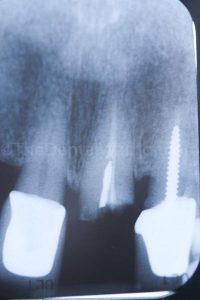
A new patient called saying a crown on her front tooth came out. We appointed her the same day (that afternoon). She has a current dentist, but he was on vacation, and the front desk did not offer to refer her to anyone on call. So, she did a search on Google and found my website. Woo-hoo! There’s a moral to that story, already eh?
Tooth #9 had snapped off at the gingival level. Half of the post was in the root. The other half was in the crown along with some coronal tooth structure and composite build-up.
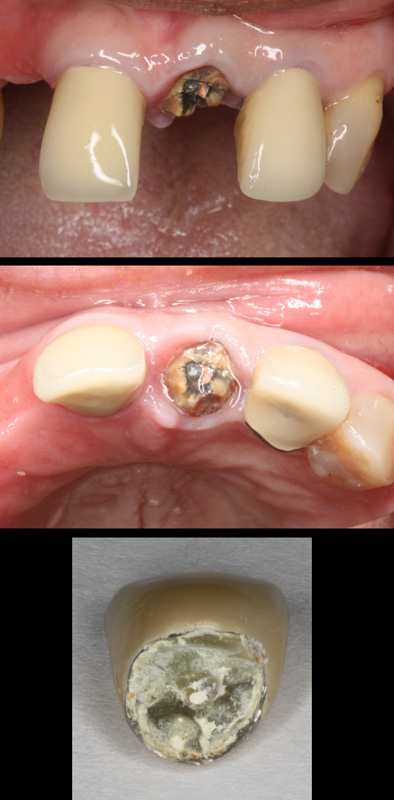
Can’t you just glue it back?
As you can see, this was not a matter of “gluing it back on.” Though the patient had tried with superglue. And, the patient was going on a vacation trip this weekend. She had an existing temporary partial denture (all-acrylic with wire clasps). So… what options does Dr. MacGyver have? In my opinion, the tooth is ultimately unrestorable. There won’t be enough ferrule to do a new post / core and new crown with any degree of predictability. What can we do to give the patient her smile back?
Is there some way to put the crown back on? Or, can we add a tooth to the partial for the time being? Maybe even attach the crown to the partial? Will that work? What about just bonding / splinting it to the adjacent teeth as a “temporary bridge?” Hmmm… bonding to porcelain is unpredictable, and this tooth will likely be under some stresses. Wait… what about removing the post from the tooth and picking up a new post in the existing crown and then cementing it with Temp-bond? That might provide enough retention for a temporary solution. Well… why not just secure a new post in the root and then retrofit the crown to a new build-up? Use the good “permanent” stuff. Yeah… that’s the ticket! Well…. IF I can get the post out of the root.
How are we going to do this?
Before I do all that, how will I orient or position the crown back to where it was? Just free-hand it? Eyeball it? If I drill out all the build-up and tooth inside the crown, there’s nothing left to orient it on the remaining root. So, before I remove anything, I needed to create an index. As it was, I could put the two puzzle pieces together, but they wouldn’t stay together when gravity had its effect. So, I held the crown in place on the root with my fingers and then tacked it to the adjacent teeth with some flowable composite. Then I injected some Blu Mousse (Parkell) bite registration material on the palatal side of the anterior teeth to create a positioning index.
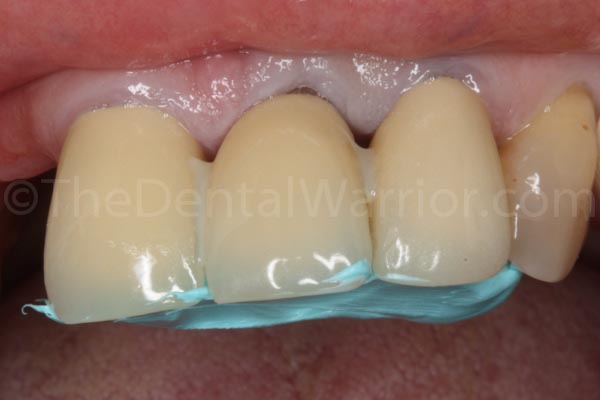
#9 crown tacked into place with flowable composite. Blue Mousse injected on palatal to create index.
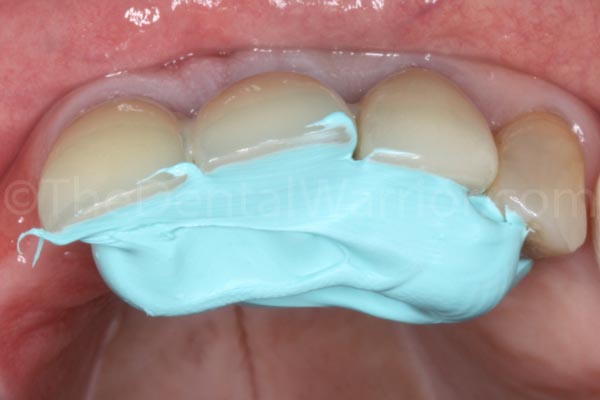
Blu Mousse injected across palatal of anterior teeth to create a positioning index to be used later.
Once the Blu Mousse set, I removed the index and set it aside. I then popped the tacked-on crown off.
Next, I carefully removed the post from the root by troughing around it with a thin diamond. Fortunately, the post was fairly short. Once I got it out, I prepped the canal for a new post and secured a Parapost XT (Whaledent) with RelyX Unicem (3M). I was also able to engage some of the threads on the post.
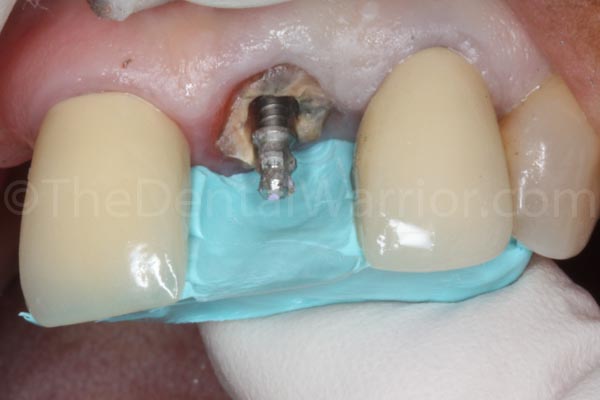
Parapost XT trial fitted and Blu Mousse index in place.
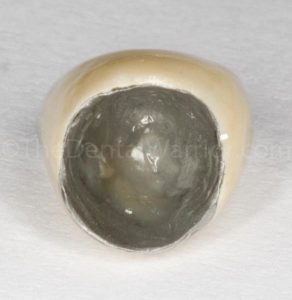
Crown cleaned out. Bonding agent already applied to intaglio at the time of photo.
I used my handpiece and a diamond to remove the build-up and coronal tooth structure from the intaglio of the crown. I seated the crown with the Blu Mousse index and realized it wasn’t clearing the new post. I used a football diamond to modify the palatal aspect of the post head to create clearance for the old crown. Then I sandblasted the intaglio of the crown and applied and cured some Scotchbond Universal (3M). I etched and bonded the root.
I injected Anchor (Apex Dental) composite build-up material around the post and then filled the crown completely. I had my assistant hold the Blu Mousse index firmly on the other teeth while I seated the composite-filled crown to place. I used a combination of cotton rolls and a microbrush to quickly clean up excess composite extruded around the facial and interproximal margins. I made sure my assistant was holding the index in place while I was doing this.
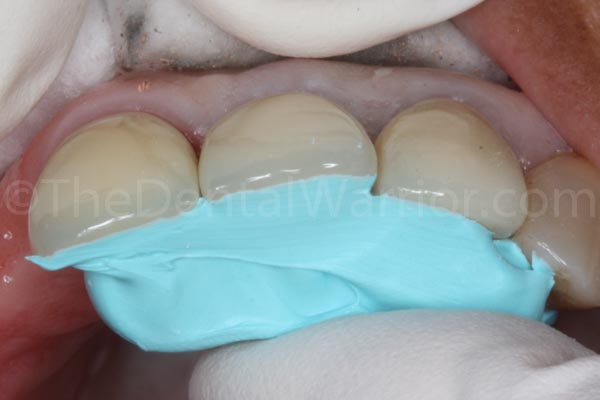
Crown seated using the positioning index.
And then what?
I “zapped” the facial margin with the curing light (Ultradent Valo) and then continued to hold the Blu Mousse index in place while the composite continued to chemically cure. After a few minutes, I removed the positioning index and had the patient rest on a couple of cotton rolls (placed away from #9, leaving it undisturbed) to allow the composite to chemically cure another 10 minutes.
I removed the remaining excess composite with scalers and rotary instruments. I checked and adjusted the occlusion to eliminate centric hits and protrusive excursions.
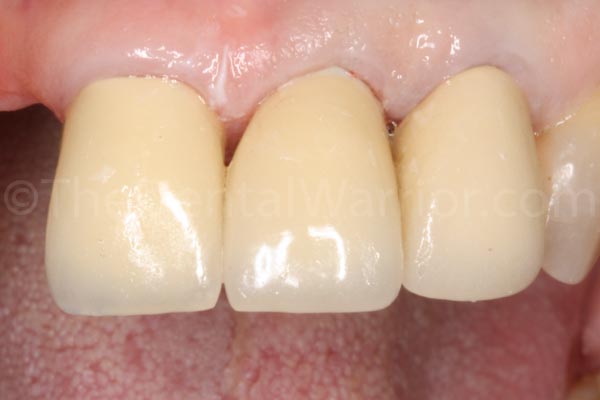
Crown #9 “glued back!”
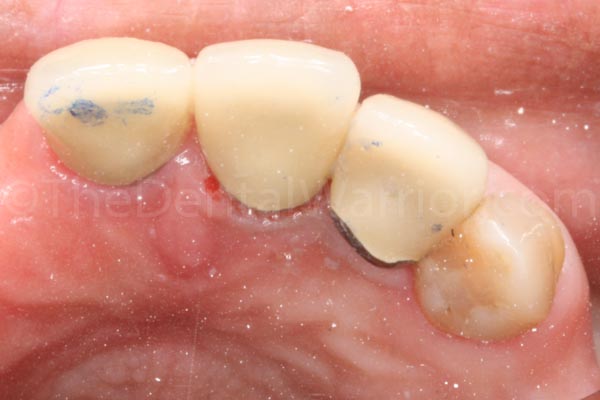
Palatal view of #9 after “MacGyver” procedure.
Presto! The patient has her tooth back! Of course, I told her this was “temporary,” and that she needed a comprehensive approach to her future treatment plan. She then said, “Well, my dentist takes a lot of vacations. I might just come here.” I smiled and told her, “My intent is not to poach patients from another dentist. But, you are free to do as you please.”
What’s the code?
I submit that putting a value (fee) on this procedure is challenging. There is no “code” for it. Forget about submitting to insurance (if the patient has insurance). We almost can’t charge enough for the work involved. On the other hand, it’s a “temporary” procedure, so the fee needs to reflect that in order to make it palatable to the patient. In the end, I actually enjoyed doing it. It was fun! The patient was very happy, of course. We’ll see what happens next! Feel free to comment below!
 Copyright protected by Digiprove © 2017-2018 The Dental Warrior®
Copyright protected by Digiprove © 2017-2018 The Dental Warrior® 
nice job, as usual, Dr Warrior.
What do you think about augmenting the surface prep of the root-stub, (and crown intaglio), with air-abrasion?
It might have helped. I have it available chairside. But, it also might have elicited a bunch of gingival bleeding. So, I decided to not use it. I figure the post provided most of the “retention” anyway. I did sandblast the crown intaglio with a lab unit.
Excellent MacGuyvering!! I love the locking it in place first and making a positioning index. No surprises at the critical moment of putting itback on as theself cure stuff sets. I like the flexi posts(split shank ones) because of the threaded design. Active hold. The Anchor from Apex is a dual cure composite? Well done!! You really got this patient put back together in a solid way! Even if a temporary fix. I would foresee her becoming your patient for sure. Thanks for posting this. Super awesome and I look forward to implementing your technique. Wishing you All The Best, Alvaro
Thanks, Alvaro! Yes, Anchor is a dual-cured composite build up material.
I’ve done this several times, but the bite index before is a Great idea. My fear is always orientating the existing crown incorrectly. Will use it next time this situation occurs. Thanks for the tip.If you wanted to submit this to insurance do you think you could use 0140-limited exam, 0120- PA radiograph,2954-prefab post and core, recement crown -2920? I think there is even a code for removing a post.Always enjoy your posts-no dental pun intended. 🙂
Great job!!
I believe previous poster is correct on how to
bill this out honestly and fairly.
Sometimes these last a long time.
Nice service for the patient.